Key achievements
"A new take on construction" is more than just a slogan for Lafarge. The time has come to develop "sustainable" buildings which take account of ecologically sound materials, advances in construction techniques and respect for the environment. Discover recent construction projects to which the Group has contributed.
Lafarge's key achievements
Hypergreen, a multi-function tower concept |
|
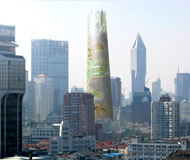 Lafarge and architectsLafarge works closely with leading architects, promoters and builders to develop sustainable construction methods.
|
The Peace Bridge, designed by architect Rudy Ricciotti, crosses the Han River to link the island of Sunyudo to the center of Seoul. It was built in 2002 with ultra‑high performance Ductal® concrete. "This footbridge has a span of 130 meters but the deck (horizontal platform) is only 3 cm thick!" Rudy Riciotti points out. This exceptional feat was made possible thanks to Ductal®. |
The Peace Bridge in Seoul, South Korea |
|
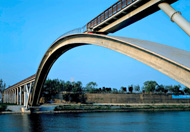 |
The Peace Bridge, designed by architect Rudy Ricciotti, crosses the Han River to link the island of Sunyudo to the center of Seoul. It was built in 2002 with ultra‑high performance Ductal® concrete. "This footbridge has a span of 130 meters but the deck (horizontal platform) is only 3 cm thick!" Rudy Riciotti points out. This exceptional feat was made possible thanks to Ductal®. |
The Spinnaker Tower in Portsmouth, United Kingdom |
|
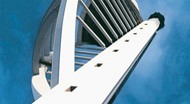 Self-leveling concreteA variant of self-placing concretes, self-leveling concretes have a specially formulated and graded composition to ensure a fluid spread. They form smooth-surfaced slabs with no need for vibration or float finishing (used to make a surface flat).
|
The Spinnaker Tower, designed by Scott Wilson Advanced Technology Group, was built in 2004 with Agilia® self-positioning, self-leveling concrete. The highest tower in England, it rises 170 meters above sea level. The Spinnaker Tower offers a panoramic view extending for 23 miles (37 km) and boasts 3 different panoramic viewpoints. |
Rion-Antirion Bridge, in Greece |
|
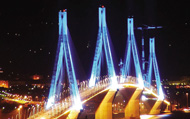 |
Built in 2004 by Gefyra, this bridge links the Peloponnesus with continental Greece. With a length of 2,800 meters, it is the longest suspension bridge ever built. 750,000 tons of high-performance aggregates were used to ensure the structure is durable and extremely strong. The bridge can resist winds of up to 250 km/h, a collision with an 180,000-ton oil tanker, or an earthquake of magnitude 7 on the Richter scale. |
Ocho al Cubo, Chile |
|
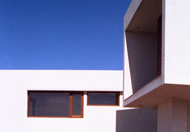 |
Eight of Chile's finest architects were invited to design their ideal house in the luxurious setting of the Marbella seaside resort. They produced spacious white houses in a variety of styles. However, they had one point in common: their use of architectonic Lafarge Premix concrete (over 2,500 m³). Through this project, Lafarge established itself as the reference for architectonic concrete and consolidated its reputation among architects. |
Eco-City, South Africa |
|
 |
The Eco-City Project was launched by the W.W.F. and local N.G.O.s in a deprived township of Johannesburg. The project builds low-cost, environment-friendly housing and makes it available to families at the lowest end of the income scale. The overall goal is to reduce pollution and poverty in the township. The project focuses on passive solar heating, rainwater recovery and the use of recyclable materials. Lafarge provided the cement which was mixed with polystyrene scrap to produce cost-effective insulation panels. Concrete and cement also have a role to play in sustainable construction! |
Completed architectural projects |
|
|
To discover structures and buildings created with Lafarge products, click on the following links: |
|



